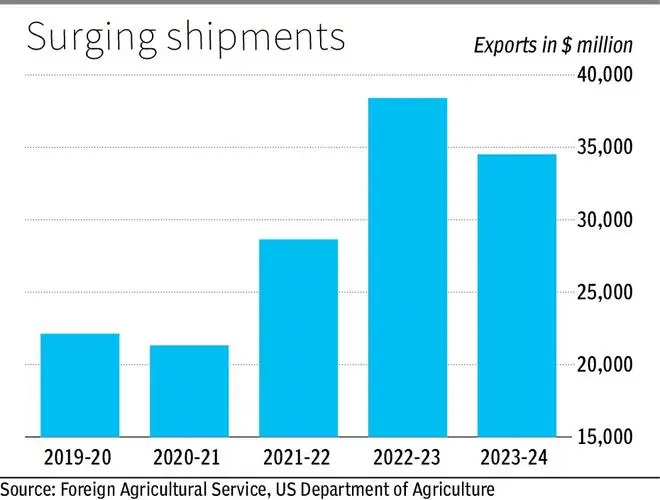The Economic Research Service of the US Department of Agriculture data showed that India was the sixth-largest overall export market for the US.
Indian buyers have “paused” imports of US agricultural products, mainly pulses and lentils, fearing the Narendra Modi government could retaliate against the Donald Trump administration’s punitive tariffs.
“Indian importers have signed fresh contracts, but they have put on hold all loadings until the end of August. They fear New Delhi might come up with retaliatory tariffs,” said a source from a multinational firm, who did not wish to be identified.
Currently, US bean and lentil crops are being harvested. The US exports green lentils – a substitute for pigeon peas (tur) – yellow peas and chickpeas to India.

TN buys green lentils
US green lentils find their way to Tamil Nadu, where the state is distributing them through ration shops. At least 44,000 tonnes of US green lentils were exported to India last year. Some buyers in Tamil Nadu sell these lentils in interior south, the source said.
“A Thoothukudi buyer has bought 10,000 tonnes of green lentils but is not allowing the loading of the consignment onto the vessel. It may be the case with other agricultural products too,” said the source.
A few trading firms have entered into deals to export, but are waiting for the green signal from the buyers to load the consignments on ships. The firms have to buy these produce from farmers as they have entered into a forward contract and provided security bonds.
Six weeks in transit
This comes as an additional worry for US farmers, who are anxious over China not contracting any forward deal of their upcoming soyabean crop. “Even corn, China’s purchase has bought only very little,” said a global inspection agency official.
However, the trading source said China may not enter into any new forward contract to buy US corn, which will be harvested in October.
Indian fears over importing US produce stem from Trump saying that Washington will levy an additional 25 per cent duty from August 27 for buying crude oil from Russia. It imposed a 25 per cent tariff on the import of Indian products from August 7 on the grounds that New Delhi was imposing higher Custom duties on US goods.
It takes at least six weeks for shipments to arrive in India from the US. Buyers do not want to be caught off-guard with their shipments midway in the event of India retaliating. Trade negotiations between India and the US have paused, with Trump saying no talks will take place until India stops buying Russian crude oil.
Sixth largest market
Data show that the US exported agricultural products worth $2.27 billion to India in 2024. The major produce shipped were tree nuts, ethanol, cotton, pulses and fresh fruits.
This week, India made cotton import duty-free, which is some relief for the US growers. However, the duty-free regime ends on September 30.
Ramnath Thakur, Union Minister of State for Agriculture and Farmers’ Welfare, told the Lok Sabha on July 29 that the import of cotton from the US increased from 2.69 lakh bales (170 kg) valued at ₹1,361 crore in 2023-24 to 5,26 lakh bales valued at ₹1,802 crore till May during the current season ending September 30.
The Economic Research Service of the US Department of Agriculture data showed that India was the sixth-largest overall export market for the US.
(The writer is in the US on the invitation of US Soybean Export Council)
More Like This
Published on August 22, 2025

